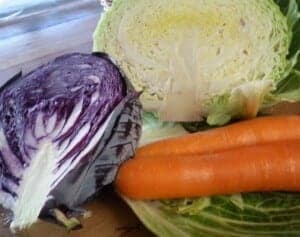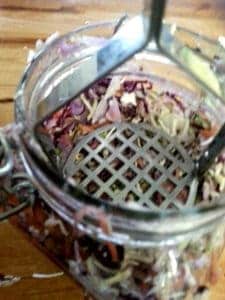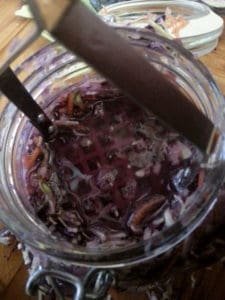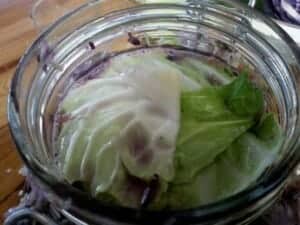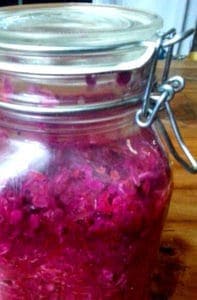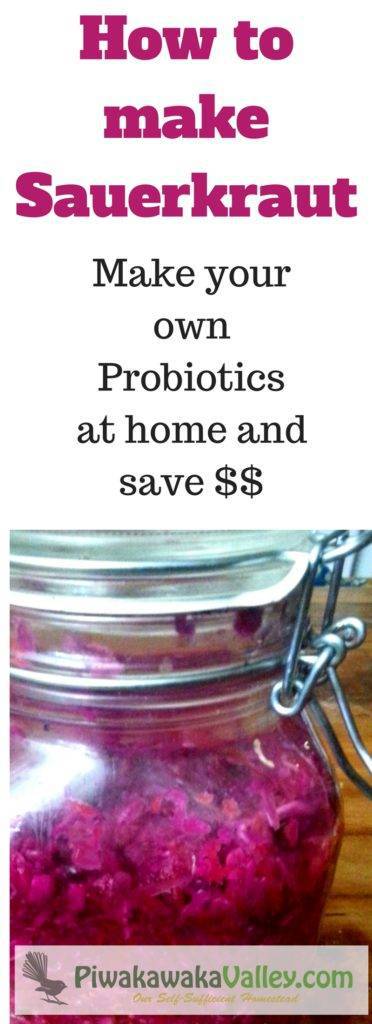This post was most recently updated on April 1st, 2021
Why do I eat and make sauerkraut? I am a big believer in getting the things you need from foods rather than pills. Making sauerkraut at home is super easy and the probiotics that it contains are so good for you.
Please read: This information is provided for educational purposes only and is not intended to treat, diagnose or prevent any disease. We encourage you to make your own health care decisions in partnership with a qualified health care professional.
This post contains affiliate links, this means at no extra cost to you, we make a commission from sales. Please read our Disclosure Statement
I also think we as a society are getting sicker and sicker due to our worsening gut health. Did you know that bacteria in our bodies outnumber our own cells to about 10 to 1?
We are more bacteria than we are human.
Gross. Haha, that totally weirds me out.
How to make your own probiotics
Making probiotics at home is really easy with this sauerkraut recipe. A spoonful of live fermented sauerkraut has more beneficial bacteria in it than a whole bottle of probiotics from the store.
Health Benefits of Sauerkraut
Recent studies are showing just how much beneficial gut bacteria (your microbiota) play important roles in your body. They help with vitamin production, mineral absorption, detoxification, and helping prevent diabetes, digestive issues, neurological problems and cardiovascular disease.
Your microbiota also plays a large role in your metabolism; sugar, refined carbohydrates and junk foods cause certain bacteria to release endotoxins. These drive inflammation and cause metabolic changes that result in overproduction of insulin, increased appetite, increased fat storage and obesity (1).
Studies, where they have given fat rats the bacteria from thin rat’s, has caused the fat rats to lose weight and visa versa (2).
One of the best ways to protect your health is by keeping your gut healthy by eating naturally fermented foods like sauerkraut every day.
Probiotic capsules usually contain around 10 billion colony-forming units per capsule – a single 1/2 cup serving of fermented vegetables contain 10 TRILLION!
How does Natural Fermentation work?
All organic fruit and vegetables, the dust on our soils, and all plant matter are covered with Lactobacilli. The fresh cabbage leaves will be covered in these lacto-fermenting bacteria. These are the bacteria that help natural fermentation to happen.
You don’t need to add anything to get this bacteria to work. Although some people choose to add some starter culture to ensure a larger range of bacteria.
All you need to do is chop the cabbage up and add some salt in the initial stages to stop putrefactive bacteria from multiplying.
RELATED: Make your own sourdough starter
Then as the Lactobacillus starts to work and they multiply, they produce lactic acid. That’s why they’re called Lactobacillus.
If you look at the research in lactic acid, it is one of the most powerful antiseptics. It kills off lots and lots of bad bacteria and it will kill off all those putrefactive and pathogenic microbes and preserve the food. Lactic acid is a great preservative.
A good batch of sauerkraut can keep for five to six years without spoiling or rotting, as long as it is covered by its own juice (3).
RELATED: Lazy persons guide to making kombucha
How to make your own probiotic sauerkraut
You need:
Cabbage – red or green or savoy or a mixture
Salt
Optional – Carrots, beets, chillies, celery, cauliflower etc
A large glass jar or croc – I like these fermenting crocs
A wooden spoon or potato masher
To make enough for a 2-litre (2 quarts) jar of sauerkraut I used 2 large carrots and 1/2 a large green cabbage and 1/2 a small red one.
Finely grate/chop or shred your vegetables to the consistency of coleslaw. I throw them all through my food processor – using the grater blade for carrots etc and slicer blade for the cabbage.
Put them all in a large bowl and with clean hands, add 1-2 teaspoons of salt and mix thoroughly, squeezing as you go.
Sit aside for 30-60 minutes and the salt will start working some of the juice out of the cabbage. If you choose to use a started culture, add it now dissolved in 1/4 Cup of cold water.
Start packing the sauerkraut mixture into your jar, stopping at about half full to squish down with a potato masher or wooden spoon and again at 3/4 full. Keep adding more sauerkraut mix and squishing it in.
Keep adding more sauerkraut mix and squishing it in.
The aim is to get all the air out and get the top submerged in its own juices.
Once you are near the top, use a piece of an unused outer leaf of the cabbage to cover the top and help keep the shredded sauerkraut mixture below the juice. You can hold it all submerged with a small glass jar that is filled with water as a weight.
Sit at room temperature for 7-10 days. Start tasting it daily, when it is pleasantly sour you can pop it in the fridge to stop it souring further.
Storing homemade sauerkraut
You can leave it totally unrefrigerated if you like. But it will become increasingly sour, and if you like it that sour – go for it. The sauerkraut will have more beneficial bacteria in it the sourer it becomes.
Eating homemade sauerkraut
When you start eating probiotics like sauerkraut you can cause a ‘die-off reaction’ in your gut. This is from all the bad bacteria being killed off resulting in an upset tummy. I suggest you start with just 1-2 teaspoons per day and slowly build up to 1/4-1/2 cup one to two times per day.
For further reading I recommend these two books:
Do you make sauerkraut at home? What is your favourite flavour combination?
If you like tips on frugal living, self sufficiency and consuming less, sign up to our newsletter below, I would LOVE to have you!
Delicious probiotic sauerkraut recipe that you can make easily at home To make enough for a 2-litre (2 quarts) jar of sauerkraut I used 2 large carrots and 1/2 a large green cabbage and 1/2 a small red one.
Probiotic Sauerkraut
Ingredients
Instructions
Finely grate/chop or shred your vegetables to the consistency of coleslaw. I throw them all through my food processor - using the grater blade for carrots etc and slicer blade for the cabbage.
Put them all in a large bowl and with clean hands, add 1-2 teaspoons of salt and mix thoroughly, squeezing as you go.
Sit aside for 30-60 minutes and the salt will start working some of the juice out of the cabbage. If you choose to use a started culture, add it now dissolved in 1/4 Cup of cold water.
Start packing the sauerkraut mixture into your jar, stopping at about half full to squish down with a potato masher or wooden spoon and again at 3/4 full. Keep adding more sauerkraut mix and squishing it in.
Keep adding more sauerkraut mix and squishing it in.
The aim is to get all the air out and get the top submerged in its own juices.
Once you are near the top, use a piece of an unused outer leaf of the cabbage to cover the top and help keep the shredded sauerkraut mixture below the juice. You can hold it all submerged with a small glass jar that is filled with water as a weight.
Sit at room temperature for 7-10 days. Start tasting it daily, when it is pleasantly sour you can pop it in the fridge to stop it souring further.


